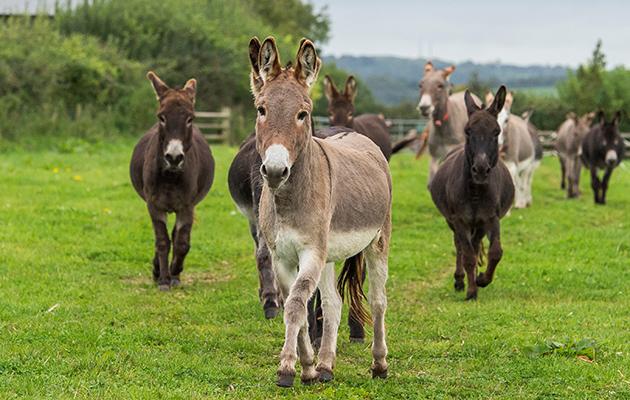While few donkeys in the UK still work as pack animals or at the seaside, many are kept as companions. A naturally calm and inquisitive nature means donkeys make excellent therapy animals, and they are often used in assisted learning programmes.
The donkey evolved from the African wild ass, in and around the area now known as Somalia. They were first domesticated in Egypt, more than 5,000 years ago, and have been closely associated with humans ever since.
{"content":"PHA+V2l0aCBvcmlnaW5zIGluIGFuIGFyaWQgZGVzZXJ0IGNsaW1hdGUsIHdoZXJlIHZlZ2V0YXRpb24gYW5kIG90aGVyIGZvb2Qgc291cmNlcyBhcmUgdHlwaWNhbGx5IHNwYXJzZSwgZG9ua2V5cyBmYWNlIHVuaXF1ZSBoZWFsdGggY2hhbGxlbmdlcyB3aGVuIGxpdmluZyBpbiBjb29sZXIsIHdldHRlciByZWdpb25zLiBUaGUgcmVhZHkgc3VwcGx5IG9mIGhpZ2gtcXVhbGl0eSwgaGlnaC1jYWxvcmllIGZlZWRzIGFuZCBsdXNoIGdyYXppbmcgaW4gY291bnRyaWVzIHN1Y2ggYXMgdGhlIFVLLCBjb3VwbGVkIHdpdGggYSByZWxhdGl2ZWx5IHNlZGVudGFyeSBsaWZlc3R5bGUsIGhhcyBsZWQgdG8gd2lkZXNwcmVhZCBvYmVzaXR5IGlzc3Vlcy48L3A+CjxwPk92ZXJ3ZWlnaHQgZG9ua2V5cyBhcmUgYXQgcmlzayBvZiBlcXVpbmUgbWV0YWJvbGljIHN5bmRyb21lIChFTVMpLCBhcyB3ZWxsIGFzIGxhbWluaXRpcy4gV2V0LCBoZWF2eSBncm91bmQgY2FuIGFsc28gYmUgY2hhbGxlbmdpbmcgZm9yIGRvbmtleSBob292ZXMsIHdoaWNoIGFyZSBhZGFwdGVkIHRvIHRoZSBkZXNlcnQuPC9wPgo8cD5IeXBlcmxpcGFlbWlhLCBhIGNvbmRpdGlvbiB0aGF0IGFmZmVjdHMgZG9ua2V5cywgbWluaWF0dXJlIGRvbmtleXMgYW5kIHNtYWxsIHBvbnkgYnJlZWRzLCBjYW4gYWxzbyBiZSBmYXRhbC4gSWYgYSBkb25rZXkgc3RvcHMgZWF0aW5nIGVub3VnaCwgaGlzIHZpdGFsIG9yZ2FucyBzdGlsbCByZXF1aXJlIGEgc3VwcGx5IG9mIGZ1ZWwg4oCUIHNvIGhpcyBib2R5IGJlZ2lucyB0byBtb2JpbGlzZSBlbmVyZ3kgc3RvcmVkIGFzIGZhdCBkZXBvc2l0cy48L3A+CjxwPjxkaXYgY2xhc3M9ImFkLWNvbnRhaW5lciBhZC1jb250YWluZXItLW1vYmlsZSI+PGRpdiBpZD0icG9zdC1pbmxpbmUtMiIgY2xhc3M9ImlwYy1hZHZlcnQiPjwvZGl2PjwvZGl2PjxzZWN0aW9uIGlkPSJlbWJlZF9jb2RlLTMxIiBjbGFzcz0iaGlkZGVuLW1kIGhpZGRlbi1sZyBzLWNvbnRhaW5lciBzdGlja3ktYW5jaG9yIGhpZGUtd2lkZ2V0LXRpdGxlIHdpZGdldF9lbWJlZF9jb2RlIHByZW1pdW1faW5saW5lXzIiPjxzZWN0aW9uIGNsYXNzPSJzLWNvbnRhaW5lciBsaXN0aW5nLS1zaW5nbGUgbGlzdGluZy0tc2luZ2xlLXNoYXJldGhyb3VnaCBpbWFnZS1hc3BlY3QtbGFuZHNjYXBlIGRlZmF1bHQgc2hhcmV0aHJvdWdoLWFkIHNoYXJldGhyb3VnaC1hZC1oaWRkZW4iPg0KICA8ZGl2IGNsYXNzPSJzLWNvbnRhaW5lcl9faW5uZXIiPg0KICAgIDx1bD4NCiAgICAgIDxsaSBpZD0ibmF0aXZlLWNvbnRlbnQtbW9iaWxlIiBjbGFzcz0ibGlzdGluZy1pdGVtIj4NCiAgICAgIDwvbGk+DQogICAgPC91bD4NCiAgPC9kaXY+DQo8L3NlY3Rpb24+PC9zZWN0aW9uPjwvcD4KPHA+VGhlc2UgZnJlZSBmYXR0eSBhY2lkcyBhcmUgY2lyY3VsYXRlZCB0byB0aGUgbGl2ZXIgdG8gYmUgY29udmVydGVkIGludG8gZ2x1Y29zZSwgdGhlIG1haW4gZnVlbCB1c2VkIGJ5IGFsbCBjZWxscywgaW4gYSBwcm9jZXNzIGNvbnRyb2xsZWQgYnnCoGEgc2VyaWVzIG9mIGNvbXBsZXggaG9ybW9uYWwgZXZlbnRzLiBVbmZvcnR1bmF0ZWx5LCBkb25rZXlzIGFuZCBzbWFsbCBwb25pZXMgYXJlwqBub3QgYWJsZSB0byBlZmZpY2llbnRseSDigJx0dXJuIG9mZuKAnSB0aGUgZmF0IHJlbGVhc2UuIFRoZSBjb25zZXF1ZW5jZSBvZiB0aGVzZSBoaWdoLWNpcmN1bGF0aW5nIGZhdHMsIHRlcm1lZCB0cmlnbHljZXJpZGVzLCBpcyBkZWdlbmVyYXRpb24gb2YgdGhlIGxpdmVyIGFuZCBraWRuZXlzLCBmb2xsb3dlZCBieSBpcnJldmVyc2libGUgbXVsdGktb3JnYW4gZGFtYWdlIGFuZCBmYWlsdXJlLjwvcD4KPHA+VGhlIGZpcnN0IHNpZ25zIG9mIGh5cGVybGlwYWVtaWEgYXJlIGxvc3Mgb2YgYXBwZXRpdGUgYW5kIGdlbmVyYWwgZHVsbG5lc3MuIEFsdGhvdWdoIHByZWduYW50IGplbm5pZXMgKGZlbWFsZSBkb25rZXlzKSBhbmQgdGhvc2UgbnVyc2luZyBmb2FscyBhcmUgbW9zdCBhdCByaXNrLCBhbGwgZG9ua2V5cyBjYW4gYmUgYWZmZWN0ZWQuPC9wPgo8cD5Nb3JlIGVuY291cmFnaW5nIG5ld3MgaXMgdGhhdCBkb25rZXlzIGluIHRoZSBVSyBhcmUgcGxheWluZyBhIG1ham9yIHJvbGUgaW4gbWVkaWNhbCByZXNlYXJjaC4gRG9ua2V5cyBsaXZlIGZvciBsb25nZXIgdGhhbiB0aGVpciBob3JzZSBjb3VzaW5zIGFuZCBtYW55IG9mIHRoZSBjb25kaXRpb25zIHRoZXkgc3VmZmVyIGZyb20gYXJlIGNvbXBhcmFibGUgdG8gZGlzZWFzZXMgdGhhdCBhZmZsaWN0IHVzLiBDaGFuZ2VzIGluIHRoZSBsdW5ncyBhbmQgYnJhaW5zIG9mIG9sZGVyIGRvbmtleXMsIGZvciBleGFtcGxlLCBhcmUgc2ltaWxhciB0byB0aG9zZSBzZWVuIGluIGh1bWFucyBhcyB0aGV5IGFnZS4gVGhpcyB0eXBlIG9mIHJlc2VhcmNoIGhhcyBncmVhdCBwb3RlbnRpYWwgdG8gaGVscCBib3RoIHBlb3BsZSBhbmQgZG9ua2V5cy48L3A+CjxkaXYgY2xhc3M9ImFkLWNvbnRhaW5lciBhZC1jb250YWluZXItLW1vYmlsZSI+PGRpdiBpZD0icG9zdC1pbmxpbmUtMyIgY2xhc3M9ImlwYy1hZHZlcnQiPjwvZGl2PjwvZGl2Pgo8aDM+UHVsbGluZyBwb3dlcjwvaDM+CjxwPlJvdWdobHkgMTUuNW1pbGxpb24gZXF1aWRzIOKAlCB0aGF0IGlzLCBob3JzZXMsIGRvbmtleXMgYW5kIG11bGVzIOKAlCBsaXZlIGluIEV1cm9wZSwgTm9ydGggQW1lcmljYSBhbmQgQXVzdHJhbGFzaWEuIE1vc3QgYXJlIHdlbGwgbG9va2VkIGFmdGVyIGFuZCBlbmpveSBnb29kIG51dHJpdGlvbiBhbmQgY2FyZS48L3A+CjxwPkJ5IGNvbnRyYXN0LCB0aGVyZSBhcmUgbW9yZSB0aGFuIDEwMCBtaWxsaW9uIHdvcmtpbmcgZXF1aWRzIGluIHRoZSBzby1jYWxsZWQgZGV2ZWxvcGluZyB3b3JsZC4gSW5kZWVkLCBtb3JlIHRoYW4gOTUlIG9mIHRoZSBnbG9iYWwgZG9ua2V5IHBvcHVsYXRpb24gY2FuIGJlIGZvdW5kIGluIGxvdy0gYW5kIG1pZGRsZS1pbmNvbWUgY291bnRyaWVzLjwvcD4KPGRpdiBjbGFzcz0iYWQtY29udGFpbmVyIGFkLWNvbnRhaW5lci0tbW9iaWxlIj48ZGl2IGlkPSJwb3N0LWlubGluZS00IiBjbGFzcz0iaXBjLWFkdmVydCI+PC9kaXY+PC9kaXY+CjxwPlRoZXNlIHZhc3QgbnVtYmVycyBvZiB3b3JraW5nIGFuaW1hbHMgcGxheSBhIGNydWNpYWwgcm9sZSBpbiBib3RoIHVyYmFuIGFuZCBydXJhbCBhcmVhcy4gVGhleSBwcm92aWRlIGFncmljdWx0dXJhbCBlbmVyZ3ksIHRyYW5zcG9ydCBhbmQsIGluIG1hbnkgY2FzZXMsIHRoZSBzb2xlIG1lYW5zIG9mIGdlbmVyYXRpbmcgaW5jb21lIGZvciB0aGVpciBvd25lcnMsIG1hbnkgb2Ygd2hvbSBsaXZlIGluIHBvdmVydHkuIEl0IGlzIGVzdGltYXRlZCB0aGF0IHdvcmtpbmcgYW5pbWFscyBhcmUgcmVzcG9uc2libGUgZm9yIHRocmVlLXF1YXJ0ZXJzIG9mIHRoZSB0cmFjdGlvbiBlbmVyZ3kgKHB1bGxpbmcgcG93ZXIpIGluIHRoZSBkZXZlbG9waW5nIHdvcmxkLCB3aGlsZSBhIHN0YWdnZXJpbmcgNTAlIG9mIHRoZSB3b3JsZOKAmXMgcG9wdWxhdGlvbiBkZXBlbmRzIG9uIGFuaW1hbCBwb3dlciBhcyBpdHMgbWFpbiBlbmVyZ3kgc291cmNlLjwvcD4KPHA+V2hpbGUgYSBoZWFsdGh5LCB3ZWxsLW1hbmFnZWQgZG9ua2V5IGlzIGFuIGFzc2V0IHRoYXQgY2FuIGluY3JlYXNlIGluY29tZSwgbWFueSBvd25lcnMgYXJlIHBvb3JseSBlZHVjYXRlZCBhYm91dCBhbmltYWwgd2VsZmFyZSBhbmQgbGl2ZSB0b28gcmVtb3RlbHkgdG8gYWNjZXNzIGFueSBmb3JtIG9mIHZldGVyaW5hcnkgY2FyZS4gSXQgaXMgYSBzaG9ja2luZyByZWFsaXR5IHRoYXQgOTglIG9mIHRoZSB3b3JsZOKAmXMgZXF1aW5lIHZldHMgdHJlYXQganVzdCAxMCUgb2YgdGhlIHdvcmxk4oCZcyBlcXVpZHMuPC9wPgo8ZGl2IGNsYXNzPSJhZC1jb250YWluZXIgYWQtY29udGFpbmVyLS1tb2JpbGUiPjxkaXYgaWQ9InBvc3QtaW5saW5lLTUiIGNsYXNzPSJpcGMtYWR2ZXJ0Ij48L2Rpdj48L2Rpdj4KPHA+VGhlIHdlbGZhcmUgb2Ygd29ya2luZyBkb25rZXlzIGluIGxvdy0gYW5kIG1pZGRsZS1pbmNvbWUgY291bnRyaWVzIGlzIGNydWNpYWxseSBpbXBvcnRhbnQsIG5vdCBvbmx5IGZvciB0aGUgaGVhbHRoIGFuZCBzdXJ2aXZhbCBvZiB0aG9zZSBhbmltYWxzIGJ1dCBhbHNvIGZvciB0aGUgbGl2ZWxpaG9vZHMgb2YgdGhlIHBlb3BsZSBkZXBlbmRlbnQgdXBvbiB0aGVtLiBUaGUgZGVhdGggb2YgYSBkb25rZXkgY2FuIHNwZWxsIGZpbmFuY2lhbCBydWluIGZvciBhbiBvd25lciBhbmQgZnVydGhlciBwb3ZlcnR5IGZvciBhIGZhbWlseS48L3A+CjxwPldvcmtpbmcgZG9ua2V5cyBhcmUgc3VzY2VwdGlibGUgdG8gbWFueSBtb3JlIGlsbG5lc3NlcyBhbmQgaW5qdXJpZXMgdGhhbiB0aG9zZSBzZWVuIGluIHRoZSBVSy4gVGhleSBhcmUgb2Z0ZW4gbWFsbm91cmlzaGVkLCB0eXBpY2FsbHkgd29ya2luZyBvbiBidXN5IHJvYWRzIGFuZCBidWlsZGluZyBzaXRlcy4gUHJvYmxlbXMgaW5jbHVkZSBzZXJpb3VzIHNraW4gc29yZXMsIGxhbWVuZXNzLCBmcmFjdHVyZXMsIGV5ZSBwcm9ibGVtcywgZ29hZGluZyBpbmp1cmllcywgY29saWMsIHJvYWQgdHJhZmZpYyBhY2NpZGVudHMsIGFuZCBmb290IGFuZCBmYXJyaWVyeSBpc3N1ZXMuPC9wPgo8aDM+QSBoaWRpbmcgdG8gbm90aGluZzwvaDM+CjxwPlJlY2VudGx5LCBhIG5ldyB0aHJlYXQgaGFzIGVtZXJnZWQgaW4gdGhlIGRlbWFuZCBmb3IgZG9ua2V5IGhpZGVzLCB1c2VkIGluIHRyYWRpdGlvbmFsIENoaW5lc2UgbWVkaWNpbmUuIFRoZSBnZWxhdGluIHByb2R1Y2VkIGZyb20gZG9ua2V5IGhpZGUgaXMgYSBrZXkgaW5ncmVkaWVudCBvZiBlamlhbywgd2hpY2ggaXMgdXNlZCB0byB0cmVhdCBhIHJhbmdlIG9mIGFpbG1lbnRzLiBXaXRoIGFsbW9zdCBmaXZlIG1pbGxpb24gc2tpbnMgcmVxdWlyZWQgZXZlcnkgeWVhciBmb3IgZWppYW8gcHJvZHVjdGlvbiwgdGhlIGluZHVzdHJ5IGlzIHByb2plY3RlZCB0byBuZWVkIG1vcmUgdGhhbiBoYWxmIHRoZSBjdXJyZW50IGludGVybmF0aW9uYWwgZG9ua2V5IHBvcHVsYXRpb24gb3ZlciB0aGUgbmV4dCBmaXZlIHllYXJzIHRvIG1lZXQgZGVtYW5kLjwvcD4KPHA+VGhlIGRvbmtleSBwb3B1bGF0aW9uIGluIENoaW5hIGhhcyBmYWxsZW4gYnkgdGhyZWUtcXVhcnRlcnMgc2luY2UgMTk5MiwgbGVhZGluZyB0aGUgaW5kdXN0cnkgdG8gdHVybiB0byBmb3JlaWduIHN1cHBsaWVycyDigJQgcGFydGljdWxhcmx5IGluIEFmcmljYSwgQXNpYSBhbmQgU291dGggQW1lcmljYS4gQnJhemlsIGhhcyBzZWVuIGEgMjglIHJlZHVjdGlvbiBpbiBkb25rZXkgbnVtYmVycyBzaW5jZSAyMDA3LCB3aXRoIEJvdHN3YW5hIHJlY29yZGluZyBhIDM3JSBkZW1pc2UgYW5kIEt5cmd5enN0YW4gbG9zaW5nIGhhbGYgb2YgaXRzIHBvcHVsYXRpb24uPC9wPgo8cD5UaGUgaW1wYWN0IG9mIHRoaXMgcG9wdWxhdGlvbiBjb2xsYXBzZSBoYXMgYmVlbiBmZWx0IG1vc3Qga2Vlbmx5IGJ5IHRoZSA1MDBtaWxsaW9uIHBlb3BsZSByZWx5aW5nIG9uIHRoZXNlIGFuaW1hbHMgaW4gc29tZSBvZiB0aGUgd29ybGTigJlzIHBvb3Jlc3QgY29tbXVuaXRpZXMuPC9wPgo8cD5QZXJoYXBzIG1vc3Qgd29ycnlpbmcgYXJlIHRoZSByZXBvcnRzIG9mIGFuaW1hbCB3ZWxmYXJlIGFidXNlcyBpbiB0aGUgc3VwcGx5IGNoYWluLiBBIHJlcG9ydCBieSBVSy1iYXNlZCBjaGFyaXR5IFRoZSBEb25rZXkgU2FuY3R1YXJ5IGlkZW50aWZpZWQgdGhhdCBkb25rZXlzIGFyZSBvZnRlbiBzdG9sZW4gYW5kIHRyYW5zcG9ydGVkIHRvIHNsYXVnaHRlcmhvdXNlcyBpbiB0ZXJyaWJsZSBjb25kaXRpb25zLCB3aXRoIGFuIGVzdGltYXRlZCBvbmUgaW4gZml2ZSBvZiB0aGVtIGR5aW5nIGluIHRyYW5zaXQuPC9wPgo8cD5CZWNhdXNlIG9mIHRoZSBzY2FsZSBvZiBkZW1hbmQsIGV2ZW4gcHJlZ25hbnQgbWFyZXMgYW5kIHlvdW5nIGZvYWxzIOKAlCBhcyB3ZWxsIGFzIHNpY2sgYW5kIGluanVyZWQgZG9ua2V5cyDigJQgYXJlIHRyYWRlZC4gVGhlIHJlcG9ydCByZXZlYWxzIHRoZSB0cmFkZSBhbHNvIHByZXNlbnRzIGJpb3NlY3VyaXR5IHJpc2tzLCB3aXRoIHVuaHlnaWVuaWMgcHJhY3RpY2VzIGVuY291cmFnaW5nIHRoZSBzcHJlYWQgb2YgZGlzZWFzZXMgc3VjaCBhcyBhbnRocmF4LCB0ZXRhbnVzIGFuZCBlcXVpbmUgZmx1IGFjcm9zcyB2YXN0IHJlZ2lvbnMgb2YgdGhlIHdvcmxkLjwvcD4KPHA+TWFueSBncm91cHMgYXJlIHdvcmtpbmcgdG8gc3VwcG9ydCBkb25rZXlzLCBtdWxlcyBhbmQgdGhlaXIgb3duZXJzLiBUaGUgRG9ua2V5IFNhbmN0dWFyeSwgd2hpY2ggdGhpcyB5ZWFyIGNlbGVicmF0ZWQgaXRzIDUwdGggYW5uaXZlcnNhcnksIGlzIGFjdGl2ZSBpbiBtb3JlIHRoYW4gNDAgY291bnRyaWVzIGFuZCBpcyBhbiBhZHZvY2F0ZSBmb3IgZG9ua2V5IGFuZCBodW1hbiB3ZWxmYXJlIHdvcmxkd2lkZS48L3A+CjxwPlRoZXNlIGNoYXJpdGllcyBuZWVkIG91ciBzdXBwb3J0IOKAlCBub3QganVzdCB0byBrZWVwIHRoZSBhcm15IG9mIHdvcmtpbmcgYW5pbWFscyBvbiB0aGUgcm9hZCwgYnV0IHRvIGVuc3VyZSB0aGUgaGVhbHRoIGFuZCB3ZWxmYXJlIG9mIGFsbCBkb25rZXlzIGFjcm9zcyB0aGUgZ2xvYmUuPC9wPgo8aDM+U25vd2Ryb3DigJlzIHNpemVhYmxlIHNhcmNvaWQ8L2gzPgo8cD5XaGVuIGEgbWVtYmVyIG9mIHRoZSBwdWJsaWMgbm90aWNlZCB0aGVpciBkaXJlIHN0YXRlIG9mIGhlYWx0aCBsYXN0IHllYXIsIGRvbmtleXMgTWFyYmxlIGFuZCBTbm93ZHJvcCB3ZXJlIHJlbGlucXVpc2hlZCBpbnRvIHRoZSBjYXJlIG9mIFRoZSBEb25rZXkgU2FuY3R1YXJ5LjwvcD4KPHA+U25vd2Ryb3Agd2FzIHN1ZmZlcmluZyBmcm9tIGEgcGFydGljdWxhcmx5IGFnZ3Jlc3NpdmUgc2FyY29pZCwgd2hpY2ggd2FzIGluIGNsb3NlIHByb3hpbWl0eSB0byBoZXIgcmlnaHQgZXllLiBUaGUgYmxlZWRpbmcgdHVtb3VyLCB3aGljaCB0aHJlYXRlbmVkIGhlciB2aXNpb24sIHdhcyBjYXVzaW5nIG9idmlvdXMgZGlzY29tZm9ydCBhbmQgbmVlZGVkIGltbWVkaWF0ZSBhdHRlbnRpb24uPC9wPgo8cD5BIHBlZHVuY3VsYXRlZCBzYXJjb2lkIOKAlCBzbyBuYW1lZCBiZWNhdXNlIGl0IGlzIG9uIGEgc3RhbGsg4oCUIGNhbiBiZSBjaGFsbGVuZ2luZyB0byB0cmVhdC4gVmV0cyBhdCB0aGUgY2hhcml0eeKAmXMgc3RhdGUtb2YtdGhlLWFydCBob3NwaXRhbCBpbiBEZXZvbiBjYXJyaWVkIG91dCBhIHJlc2VjdGlvbiB3aXRoIGEgc3BlY2lhbGlzZWQgbGFzZXIgdG8gcmVtb3ZlIHRoZSBtYWpvcml0eSBvZiB0aGUgdHVtb3VyLCBmb2xsb3dlZCBieSBhIHNlcmllcyBvZiBjaGVtb3RoZXJhcHkgaW5qZWN0aW9ucyBvdmVyIHNldmVyYWwgbW9udGhzIHRvIGRlc3Ryb3kgY2VsbHMgYXQgdGhlIGJhc2Ugb2YgdGhlIHNpdGUuIEVhY2ggdGltZSBjaGVtb3RoZXJhcHkgd2FzIGFkbWluaXN0ZXJlZCwgU25vd2Ryb3Agd2FzIHNlZGF0ZWQgdG8gZW5zdXJlIHNoZSByZW1haW5lZCBjYWxtIOKAlCBwYXJ0aWN1bGFybHkgZ2l2ZW4gdGhlIHNlbnNpdGl2ZSBsb2NhdGlvbiBvZiB0aGUgdHVtb3VyLjwvcD4KPGRpdiBjbGFzcz0iaW5qZWN0aW9uIj48L2Rpdj4KPHA+VGhlIHRyZWF0bWVudCB3YXMgcmlza3kgZm9yIFNub3dkcm9wLCBidXQgYWxzbyBmb3IgaGVyIGNvbXBhbmlvbi4gRG9ua2V5cyBkZXZlbG9wIHZlcnkgY2xvc2UgYm9uZHMgYW5kIHNlcGFyYXRpb24gY2FuIGNhdXNlIGV4dHJlbWUgYW54aWV0eSwgd2hpY2ggY2FuIGluIHR1cm4gdHJpZ2dlciB0aGUgbGlmZS10aHJlYXRlbmluZyBjb25kaXRpb24gaHlwZXJsaXBhZW1pYS48L3A+CjxwPkJvdGggZG9ua2V5cyB3ZXJlIHNlcmlvdXNseSBvdmVyd2VpZ2h0IHdoZW4gdGhleSBjYW1lIHRvIHRoZSBzYW5jdHVhcnksIGJ1dCBhIHNwZWNpYWwgZGlldCBoYXMgc2luY2UgcmVzdG9yZWQgdGhlbSB0byBhbiBhcHByb3ByaWF0ZSBjb25kaXRpb24uIEFuZCBkZXNwaXRlIHRoZSBhZHZhbmNlZCBzdGF0ZSBvZiBTbm93ZHJvcOKAmXMgc2FyY29pZCwgdHJlYXRtZW50cyBzZWVtIHRvIGhhdmUgYmVlbiBzdWNjZXNzZnVsLjwvcD4KPHA+PGVtPlJlZiBIb3JzZSAmYW1wOyBIb3VuZDsgMTIgRGVjZW1iZXIgMjAxOTwvZW0+PC9wPgo8cD4K"}
This site is protected by reCAPTCHA and the Google Privacy Policy and Terms of Service apply.
